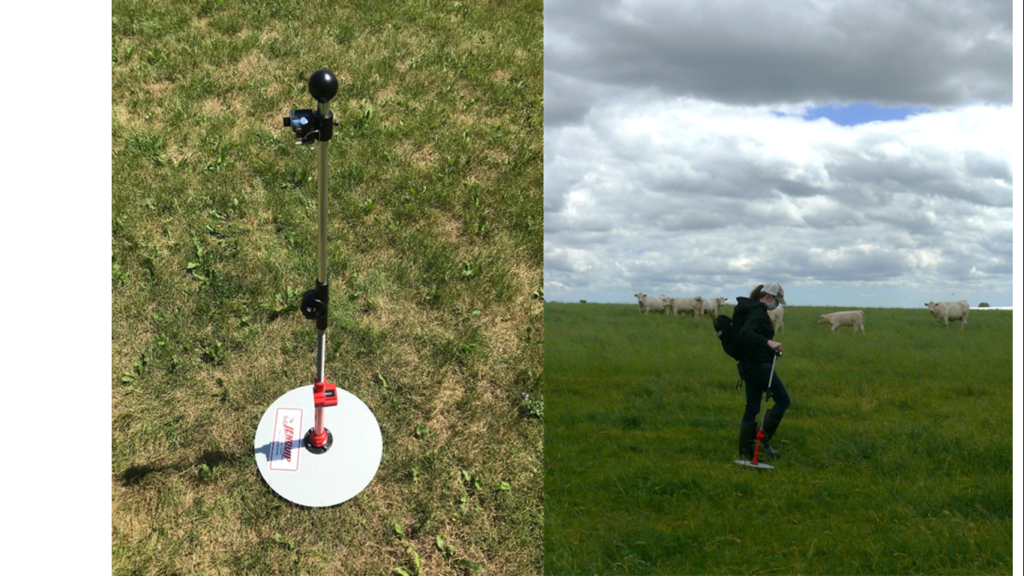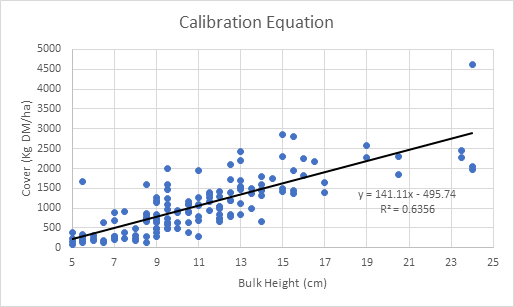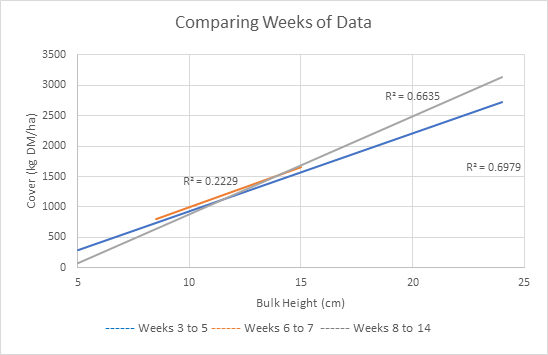This post was written by Jessica Brasier, OMAFRA summer student. Jessica works under the supervision of Christine O’Reilly (Forage and Grazing Specialist) and James Byrne (Beef Cattle Specialist).
Grazing pasture is a great way to save on feed costs and utilize marginal land. To maximize the profitability of a pasture, a producer can use different tools to aid in management decisions. One tool, the rising plate meter, gives the producer an estimate of the dry matter cover in a paddock while also being more user friendly compared to the falling plate meter. Knowing the dry matter cover of a paddock can help to determine when to move livestock, as the user can figure out how many days the livestock should stay in the paddock based on amount of available feed and how much the animals eat. This can lead to longer grazing seasons, resulting in a greater profit from pasture for producers. Also, knowing the amount of available pasture can help to determine proper stocking rates and improve pasture utilization, as the producer can measure before and after the livestock have grazed. This results in knowing the amount of cover the livestock have consumed while in a paddock, which gives the percent of pasture usage, or pasture utilization. Knowing these factors aids in maximizing the profitability of the land, making it ideal for beef, sheep, and organic dairy producers grazing on pasture to use.

What is a rising plate meter?
A rising plate meter has a round plate which rises and lowers depending on the height of the forage beneath it. This plate is connected to the shaft by a counter, which counts the number of notches on the shaft the plate moves when placed on the ground. Each notch represents half a centimeter. Placing the rising plate meter straight down on a pasture results in the plate being supported by the grass below it, which is called a plonk. Recording the initial number on the counter, then subtracting by the final number on the counter after plonking and dividing by two gets the bulk height in centimeters of the sample. The bulk height is a more accurate measurement than height as it takes density into account. As of this, plate meters are more accurate than rulers or grazing sticks. For practical use, a producer will walk in a zig zag pattern across their pasture, taking 30 to 50 plonks depending on the size of the paddock. The producer will record the initial number on the counter before starting, and after 30 to 50 plonks, record the final number. They will then subtract the initial from the final number off of the counter and divide by the amount of plonks taken, divided by 2. This will give the producer the average bulk height of the paddock, which they can then look up to find the dry matter yield in that paddock. The rising plate meter needs to be calibrated to Ontario pastures so that producers can look up accurate estimates of available forage. Calibration needs to be done over several years to ensure accuracy. The first year of calibration was the basis of this year’s summer student project.
What we did
Bulk height measurements and corresponding pasture samples were taken using the rising plate meter and a quadrat that is the same area as the plate. The grass in the quadrat was clipped at 5 cm as livestock shouldn’t graze below that height, because they can overgraze, and potentially stress or damage the forage. Livestock are also more susceptible to soil borne diseases and gastrointestinal parasites when grazing below 5 cm. The samples were dried and then weighed to find the dry weight. This was used to calculate the dry matter yield using the equation: kg DM/ha = dry mass of the samples x (100,000/area of the plate). The results are then graphed on the y axis against the corresponding bulk height measurement on the x axis. Using these points, a line of best fit is produced, giving a calibration equation as shown in figure 2.

The Switch Date
Grass growth rates change throughout the year, with rates slowing down in the summer. Producers intuitively know this as the “spring flush” and “summer slump”, and these differences in growth rate require different calibrations. The switch date is when the spring calibration is no longer accurate at estimating available pasture. The switch date can be a useful indicator of the summer slump, which is the hot and dry period in the summer where there is less available grass due to the stage of the grass growth, and the fact that there is less rain, preventing green growth. As of this, it is common to run out of feed on pasture and there may only be dried out stems due to grasses being in the reproductive stage. The switch date can indicate when the slump starts, which can help producers to take actions to get ahead of the slump. The switch date for this year was between the last week of June and the first week of July, as shown in figure 3, as the R2 value for the line combining those two weeks (weeks 6 and 7) is below 0.5. Comparing this to the falling plate meter calibration work done last year, both years have the switch date within a week of each other. Also, both were around the summer equinox, or the longest day of the year. Growth rate typically slows due to the passing of the longest day of the year, so this is also a factor into the summer slump. To prevent running out of grass or feeding extra hay to livestock on pasture, watching out for the indicators of the summer slump can be useful for pasture management. These indicators include the switch date, longest day of the year and grasses heading out or producing a seed head.

In the Future
Over the next few years, more samples will be taken across Ontario over the grazing season to produce different equations depending on factors including region and time of year. An accurate equation depending on area and season would allow Ontario producers to take measurements of their own pastures and estimate dry matter yield in their paddocks. This would help producers with management decisions to optimize performance of livestock on pasture.
References
Dennis W. Hancock, D., Tucker, J., Stewart, R., and Baxter, L. (2020). Using a Rising Plate Meter to Measure Pasture Mass. University of Georgia Extension Service.
MacAdam, J. and Hunt, S. (2015). Using a Rising Plate Meter to Determine Paddock Size for Rotational Grazing. Utah State University Extension Service.
Rayburn, E., & Lozier, J. (2003). Estimating Pasture Forage Mass from Pasture Height. West Virginia University Extension Service.
